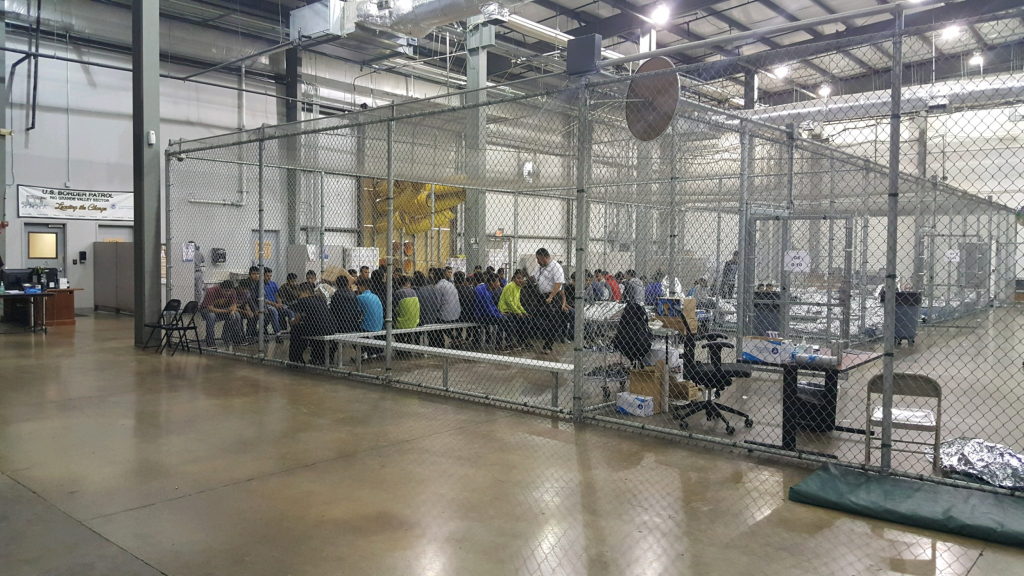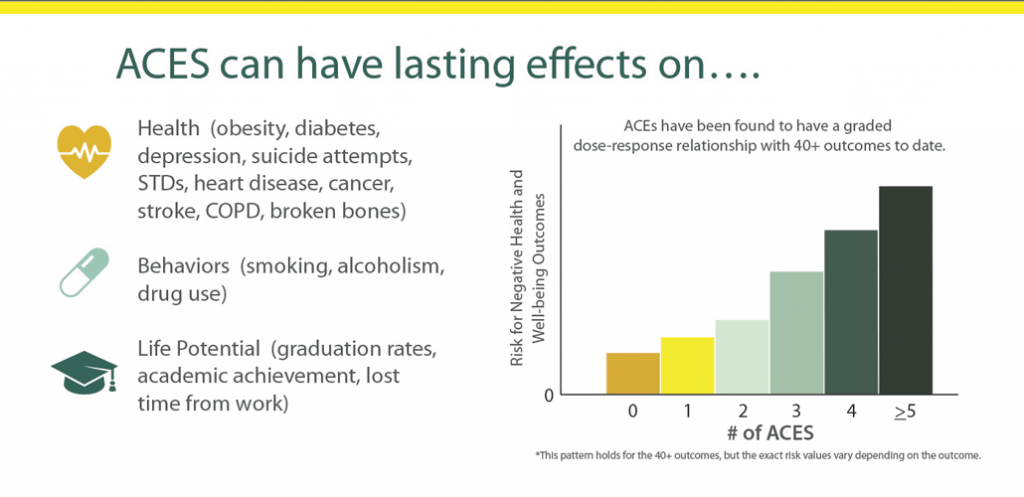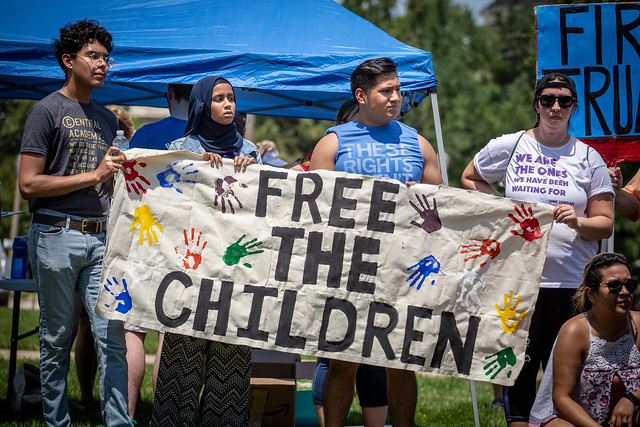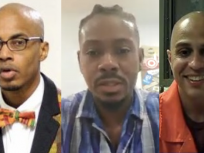Detained Children
For over a year, the Trump Administration has terrorized refugees fleeing gang violence, economic poverty and targeted killings in Central America. Many of the individuals entering the United States are children and, even though the Trump Administration claimed it ended its family separation policy in June 2018, over 12,000 children remain in custody.
While family separation may not be the official policy anymore, Trump’s “zero tolerance” immigration strategy, which is still very much in effect, “requires the detention and federal prosecution of all adults apprehended for ‘illegal entry’ at the [] border, including those seeking asylum.” When families or groups arrive, children are separated and housed separately from adults, as US law does not permit child detention in federal jail, causing de facto family separation. John Sandweg, who ran ICE under Obama between 2013-2014 acknowledged this, saying: “Permanent separation. It happens.”
After apprehension or voluntary submission to border officials, individuals seeking to enter the United States are given A-numbers and casefiles. Typically, A-numbers are consecutive and if families come in together, their numbers will likely be similar, only one or two digits off. However, there is no process or government body that “aggregates and tracks them as a family unit. A separated child is treated by the system in exactly the same way as a child who had crossed the border without their parents.” Parent and child thereby go into separate detention centers with no marker on their files to indicate them as a familial unit. For families with toddlers and preverbal infants unable to remember, identify or verbalize their connection to their parents, reunification is nearly impossible. NBC recently obtained emails from the Trump Administration that admitted that they were woefully unprepared and unable to reunite separated children.
For some children, they remain in the detention centers despite having family willing and able to care for them. One 17-year old has remained at a detention center for over five months, despite his uncle having applied to be his sponsor. A mother who has been separated from her 9-year-old son since May says that she doesn’t know where her son is, only that she thinks he may be in New York:
“My son isn’t able to give me much information about his circumstances because he is too young and too upset to understand what is happening. Every time we talk he only wants to know when he will see me again so it’s hard for him to focus on anything else.
Each time we have spoken he only cries. In the brief moments where he can speak he tells me he is ok and that he misses me very much.
My son used to be such a happy child who was always joking around with me. Now he just seems depressed—he doesn’t joke with me he only asks when we will see each other again and begs to be with me.”
“Between April and June 2018, over 2300 immigrant children, reportedly including preverbal, breastfed infants, were relocated to separate child detention shelters across the USA to await resolution of their parent’s case and hopeful, but not guaranteed, reunion.”
https://www.ncbi.nlm.nih.gov/pmc/articles/PMC6173255
Many, if not all, individuals seeking to cross into the United States endured weeks of grueling travel. Kidnappings, rape and physical attacks are common. The extreme stress experienced by children personally, and as a result of witnessing their parents’ trauma, causes deep psychological wounds. And, instead of providing a safe space for children and families to acclimate, we separate them. A young 5-year-old boy said that he was immediately separated from his father and has not seen him since:
“I was apprehended with my father. The immigration agents separated me from my father right away. I was very frightened and scared. I cried. I have not seen my father again….”
Charles Nelson, a neuroscientist and psychologist at Harvard University told Reuters, “This [family separation] is egregious and completely unnecessary. It’s a heartless act. No good is going to come out of any of this.”

In addition to the trauma of being forcibly removed from parents or guardians, children are at increased risk of abuse in separate facilities. Unlike Border Patrol facilities which host adults and are overseen by the Department of Homeland Security, shelters for immigrant children are run by private agencies under contract with the Office of Refugee Resettlement of the US Department of Health and Human Services. Despite national outcry, numerous reports and exposes, and personal statements testifying to the abuse of migrant children, both at the hands of agents and as a result of inhumane immigration policies, government officials turn a blind eye. Pacific Standard reported that, in 2018, Matthew Albence of Immigration and Customs Enforcement and Robert Perez of Customs and Border Protection stated, “they had not seen, read or considered statements released from experts from DHS, which previously revealed “‘serious compliance issues resulting in harm to children.’”
Matthew Albence and Robert Perez, the individuals responsible for executing immigration separation policies did not read statements regarding their own personnel’s compliance and allegations of abuse of children in their custody and care.
Our entire system, medical, immigration, and social services must adopt a trauma-informed approach in order to work seamlessly in treatment programs that serve a variety of individuals from varying backgrounds. We must ensure that structural barriers, such as transportation, ICE raids, inability to pay and services hours do not impede the ability of immigrants and their children to access services needed to heal the psychological wounds caused by our immigration processes.
Life Experiences, Trauma and the Impact on Children
The National Child Traumatic Stress Network describes trauma as a “frightening, dangerous, or violent event that poses a threat to a child’s life or bodily integrity.” This can include witnessing an event that threatens life or security of a loved one, often called “secondary trauma.” “Young children are especially vulnerable to both the short- and long-term effects of trauma, due in part to the rapid brain growth occurring” during childhood. When children experience stress, like being forcibly separated from their families or caregivers, stress hormones like adrenaline and cortisol flood the body. When addressed effectively, short-term stress rarely has longterm negative consequences. It’s when children have prolonged or repeated exposure to traumas that neuroplasticity, or the ability of the brain to repair itself. “In situations of multiple, prolonged, pervasive adversity [a child’s] brain will chronically adapt to a level of functioning that seeks to preserve and protect life at the expense of all peripheral learning and relationship.” In short, untreated and prolonged trauma causes the brain to function in a constant “fight of flight” state.
If stress response systems are consistently triggered through prolongued trauma, “those hormones can start killing off neurons,” eventually causing learning and behavioral problems and/or physical and mental health issues. The results include hyperarousal, hypervigilance, flashbacks, dissociative responses, emotional numbing which can often lead to self-harm in attempts to “feel,” and poor access to cognitive functioning. The constant onslaught of hormones can also negatively impact the immune system, cardiovascular system and metabolic system and even alter the physical structure of the brain. Children under three are especially susceptible to damage to the hippocampus, the area of the brain responsible for learning, memory and ability to regulate stress hormones.
The stress, trauma, and psychological harm done by border patrol agents, detention centers and their creators, the United States government and complicit citizens is harming an entire generation. A recent study published in July by researchers at the University of Wisconsin-Madison, found “that extremely high early life stress exposure in children was associated with changes in saliva DNA methlation levels…Left unminitgated, the damage caused by toxic stress can be lifelong.” Neuroplasticity and resilience often allows the brain to repair itself. However, “without the buffer of a loving and caring adult, a child suffers from ‘a massive biological stress response’ that ‘remains activated until the familiar caregiver returns,’ says Jack Shonkoff, director of Harvard University’s Center on the Developing Child.
Trauma Intervention
The current immigration system in the United States focuses on economic self-sufficiency, as evidenced by the Trump Administration’s recent decision to limit immigration by denying visas to individuals thought to become “public charges.” This decision reinforces the U.S.’ refusal to provide support for refugee children’s health and “socioemotional” development. Licensed mental health counselor, Maryellen Newman, told Psychology Today: “My clinical opinion is that we are creating a subset of immigrant children with trauma histories that will likely go untreated and may develop into lifelong deficits and struggles.” The National Center for Children in Poverty states “Early childhood trauma places a heavy burden on society…It can lead to dependence on a wide range of systems, such as child welfare, juvenile and criminal justice, and physical and behavioral health [and] can manifest in later behaviors that disrupt school and work environments.”
“Not only are these children immediately traumatized, but also their chance for a productive and happy life is significantly reduced by their experience.”
Judge Anthony Capizzi of the National Council of Juvenile and Family Court Judges
Neuroplasticity resilience highlights the need for integrative services, including “culturally competent psychological and psychiatric support where necessary for children deeply wounded and developmentally disrupted by trauma.” Many programs and organizations are working on placing services and staff at centers that focus on childhood trauma, but healing requires more than that.

Unfortunately, “distrust of anyone assumed to be associated with the government, including local police, school personnel, health professionals, and social service professionals,” and constant fear of family separation causes families to withdraw, and children to suffer. As of 2019, 5.1 million children under the age of 18 were estimated to live in mixed-status households nationally. Many of these children won’t receive the treatment that they need, despite American Orthopsychiatric Association reporting that they are more likely to report anxiety, fear, sadmess, PTSD and withdrawal. And, certainly, the children currently in detention centers are not being provided access to invested psychologists, therapists and trauma-informed social workers.
Policies do not Exist in a Vacuum
Deportations and discrimination against immigrants impact entire communities. Children can be affected by the trauma experienced by members of their surrounding community, even when their own family was not directly affected. The train of trauma transmission can even extend beyond the home in a phenomenon known as historical trauma. The reach of our policies and the acts and words of the president and our fellow citizens is far.
Our policies regarding immigration and the social services provided after resettlement are actively, directly and deliberately impeding the development of the next generation. Study after study has shown the negative impacts of trauma and, despite this, the United States continues to harbor immigrants in detention centers, separate families and deny basic human necessities such as schooling and recreation. Our current policies do not value integration and healing; they value incarceration at the expense of psychological and physical well-being — how can we forget that we denied children toothbrushes and soap?– and to the benefit of private detention centers.
Systematic continuation of traumatic experiences in detention centers, especially ones rife with physical and sexual abuse, increase the likelihood of toxic stress and negative mental health outcomes.
Through our continued inhumanity and disregard of past internments and imposed collective trauma, we deny not only the humanity of others seeking to rebuild their lives, but we deny our own humanity. Somehow, the United States government has convinced us that it is impossible to develop, maintain and promote safe, humane and healthy immigration policies and procedures. While the Trump administration cuts education and recreation in detention centers, it seeks to spend $2 billion on the Space Force. The question is not about money, it’s about priorities. Regardless the stance on immigration, surely we can agree that “traumatized moms, sick kids and baby jails” are not the way forward.





